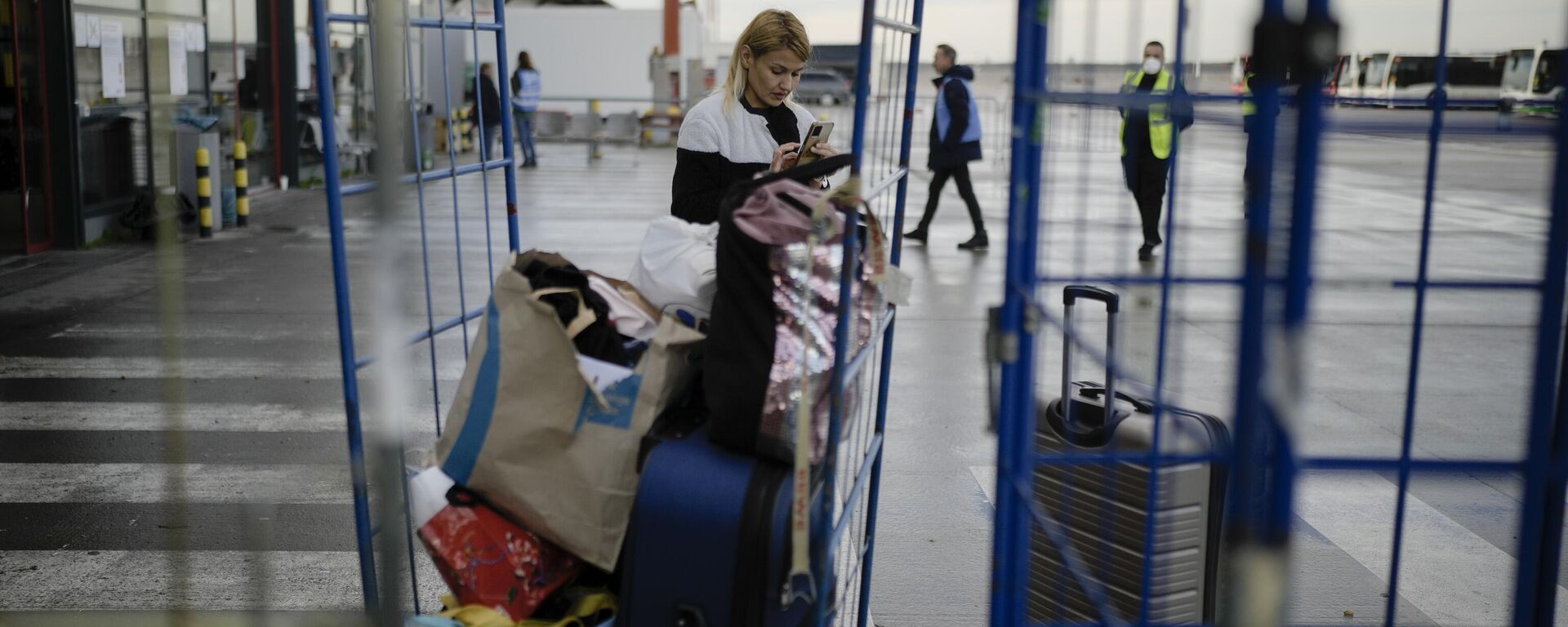https://sputnikglobe.com/20230506/eu-mulls-paying-ukrainian-refugees-to-go-home-despite-cost-implications-1110139317.html
EU Mulls 'Paying' Ukrainian Refugees to Go Home Despite 'Cost Implications'
EU Mulls 'Paying' Ukrainian Refugees to Go Home Despite 'Cost Implications'
Sputnik International
The European Union is reportedly mulling paying Ukrainian refugees social welfare to get them to go home once the temporary protection directive expires.
2023-05-06T10:45+0000
2023-05-06T10:45+0000
2023-05-06T11:22+0000
european union (eu)
ukraine
migrants
ukraine crisis
https://cdn1.img.sputnikglobe.com/img/07e7/05/06/1110138831_0:159:3078:1890_1920x0_80_0_0_e1354ffe63faa0e0ee5c161fd7f33a90.jpg
The European Union (EU) is reportedly considering the option of paying Ukrainian refugees social welfare to encourage them to return to their native country.The reason for this "generosity" is that the bloc is flummoxed as to what to do once its temporary protection directive expires in March 2024. While there is the possibility of a prolongation of the directive, nevertheless, the officials in Brussels are weighing their options, according to a report referencing policy suggestions put forward at the Cabinet committee on Ukraine.Millions of people have abandoned their homeland of Ukraine since the conflict in the country escalated in 2022, with the EU offering them special protection status. This temporary directive invoked by the European Commission in Brussels dates back to the aftermath of the Yugoslav war, and was conceived for use in the event of a "mass influx or imminent mass influx" of people into an EU state. The program that provided the refugees with housing, schooling for children, healthcare access, and work opportunities was extended by 12 months in October 2022.Incentivized ReturnsIn line with the document cited in media reports, EU states accommodating Ukrainians are to consider the option of how to “incentivize voluntary returns.” This could purportedly be done by provision of support for a specific "time-bound period" for those individuals who agree to return to Ukraine.Thus, in Ireland, for example, where a recent survey showed that 41% of Ukrainian temporary protection beneficiaries want to remain in the country for good, they can rely on a jobseekers’ allowance if under the age of 66. Older beneficiaries are paid a supplementary welfare allowance, can expect child benefits, etc.EU states are also to consider offering residency to some of the Ukrainians who are currently employed or getting an education.In any case, further extensive debate is expected among EU countries regarding a return program for Ukrainians willing to go along with it. But the report acknowledged that it would have “potentially substantial resource and cost implications.” Furthermore, migrants from Pakistan, Afghanistan, and African countries have often found themselves sidelined in favor of Ukrainians.The report comes as German Interior Minister Nancy Faeser recently proposed a stricter EU asylum policy, rooted in more rigid vetting of refugees on the EU’s external border, coupled with fast-track pushbacks."We will ensure proper identification, registration and verification of people coming to the EU’s external border," Faeser told the Handelsblatt daily.According to Faeser, EU nations made a "significant breakthrough" by agreeing a protocol that will streamline screenings. She added that under negotiation were further procedures that will make it easier to identify those with weak asylum cases before they enter the EU. The issue of Ukrainian refugees is one of the challenges that the European Union created of its own volition. Brussels eagerly rustled up self-harming sanctions packages targeting Moscow over its special military operation in Ukraine. As member states of the bloc pledged weapons deliveries to the Kiev regime, the EU also opened its arms to thousands of people who left Ukraine - some opting for the lot of a refugee living on handouts, others dodging military service. Accordingly, not only were European businesses and consumers hit with sky-high energy costs and other fallout from the sanctions, but EU states had to fork out growing costs for supporting the thousands of arriving Ukrainians.As the months passed, country after country began to rail against the costs incurred. Providing housing for refugees from Ukraine became a daunting challenge for the French authorities. They were even forced to encourage citizens to accept Ukrainian refugees by paying families 150 euros every month for hosting them. The Czech capital Prague, which saw demonstrations against the Russia sanctions, last year began to witness signs of hostility towards Ukraine. Some shops began displaying notices reading: "No entry to Ukrainians" following a string of alleged thefts and anti-social behavior in the city. Graffitied swastikas in apartments and trashed rooms by Ukrainians also didn't sit well with landlords.The bottom line is that the Ukrainian "guests" appear to have outstayed their welcome in countries of the EU.
https://sputnikglobe.com/20230414/top-15-countries-hosting-ukrainian-refugees-1109537269.html
https://sputnikglobe.com/20230505/germany-seeking-to-limit-number-of-refugees-crossing-into-eu-1110123339.html
https://sputnikglobe.com/20230228/france-spends-twice-as-much-on-ukrainian-refugees-as-on-other-migrants--1107875846.html
ukraine
Sputnik International
feedback@sputniknews.com
+74956456601
MIA „Rossiya Segodnya“
2023
News
en_EN
Sputnik International
feedback@sputniknews.com
+74956456601
MIA „Rossiya Segodnya“
Sputnik International
feedback@sputniknews.com
+74956456601
MIA „Rossiya Segodnya“
temporary protection directive, social welfare, paying ukrainias to go home, ukrainian refugees, eu, countries hosting ukrainians
temporary protection directive, social welfare, paying ukrainias to go home, ukrainian refugees, eu, countries hosting ukrainians
EU Mulls 'Paying' Ukrainian Refugees to Go Home Despite 'Cost Implications'
10:45 GMT 06.05.2023 (Updated: 11:22 GMT 06.05.2023) Amid a crumbling economy and exacerbating conflict in Ukraine, a vast stream of the country's populace in early 2022 headed for Europe, lured by the prospect of unconditional support dangled by EU officials. Reality, however, turned out to be quite harsh.
The European Union (EU) is reportedly considering the option of paying
Ukrainian refugees social welfare to encourage them to return to their native country.
The reason for this "generosity" is that the bloc is flummoxed as to what to do once its temporary protection directive expires in March 2024. While there is the possibility of a prolongation of the directive, nevertheless, the officials in Brussels are weighing their options, according to a report referencing policy suggestions put forward at the Cabinet committee on Ukraine.
Millions of people have
abandoned their homeland of Ukraine since the conflict in the country escalated in 2022, with the EU offering them special protection status. This temporary directive invoked by the European Commission in Brussels dates back to the aftermath of the Yugoslav war, and
was conceived for use in the event of a "
mass influx or imminent mass influx" of people into an EU state. The program that provided the refugees with housing, schooling for children, healthcare access, and work opportunities was extended by 12 months in October 2022.
In line with the document cited in media reports, EU states accommodating Ukrainians are to consider the option of how to “incentivize voluntary returns.” This could purportedly be done by provision of support for a specific "time-bound period" for those individuals who agree to return to Ukraine.
Thus, in Ireland, for example, where a recent survey showed that 41% of Ukrainian temporary protection beneficiaries want to remain in the country for good, they can rely on a jobseekers’ allowance if under the age of 66. Older beneficiaries are paid a supplementary welfare allowance, can expect child benefits, etc.
EU states are also to consider offering residency to some of the Ukrainians who are currently employed or getting an education.
In any case, further extensive debate is expected among EU countries regarding a return program for Ukrainians willing to go along with it. But the report acknowledged that it would have “potentially substantial resource and cost implications.”
Furthermore,
migrants from Pakistan, Afghanistan, and African countries have often found themselves sidelined in favor of Ukrainians.
The report comes as German Interior Minister Nancy Faeser recently proposed a stricter EU asylum policy, rooted in more rigid vetting of refugees on the EU’s external border, coupled with fast-track pushbacks.
"We will ensure proper identification, registration and verification of
people coming to the EU’s external border," Faeser told the Handelsblatt daily.
According to Faeser, EU nations made a "significant breakthrough" by agreeing a protocol that will streamline screenings. She added that under negotiation were further procedures that will make it easier to identify those with weak asylum cases before they enter the EU.
The issue of Ukrainian refugees is one of the challenges that the European Union created of its own volition. Brussels eagerly rustled up self-harming
sanctions packages targeting Moscow over its special military operation in Ukraine. As member states of the bloc pledged weapons deliveries to the Kiev regime, the EU also opened its arms to thousands of people who left Ukraine - some opting for the lot of a refugee living on handouts, others dodging military service. Accordingly, not only were European businesses and consumers hit with sky-high energy costs and other fallout from the sanctions, but EU states had to fork out growing costs for supporting the thousands of arriving Ukrainians.
As the months passed, country after country began to rail against the costs incurred. Providing housing for refugees from Ukraine became a daunting challenge for the French authorities. They were even forced to encourage citizens to accept Ukrainian refugees by paying families 150 euros every month for hosting them. The Czech capital Prague, which saw demonstrations against the Russia sanctions, last year began to witness signs of hostility towards Ukraine. Some shops began
displaying notices reading: "No entry to Ukrainians" following a string of alleged thefts and anti-social behavior in the city. Graffitied swastikas in apartments and trashed rooms by Ukrainians also didn't sit well with landlords.
The bottom line is that the Ukrainian "guests" appear to have outstayed their welcome in countries of the EU.

28 February 2023, 16:02 GMT




